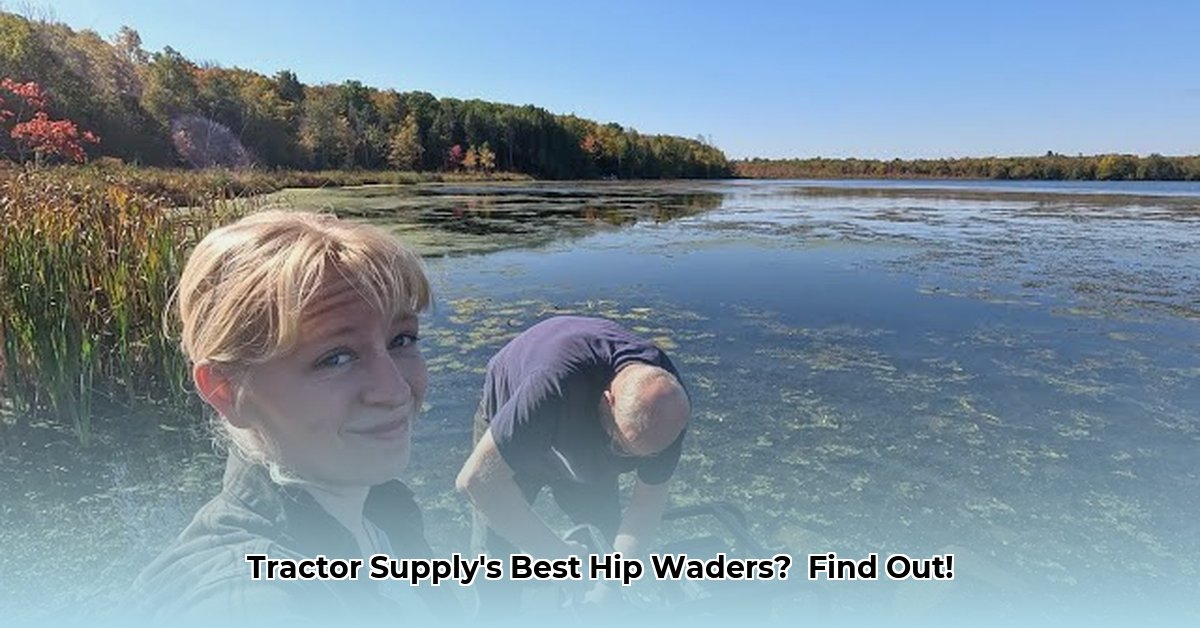
Stepping into a muddy field or a flooded ditch is part of the job for many farmers. But doing so with the right gear makes all the difference—protecting your feet, keeping you comfortable, and boosting productivity. High-quality hip waders are essential, and Tractor Supply offers a variety to suit different needs and budgets. This guide helps you choose wisely and farm sustainably.
Choosing the Right Hip Waders from Tractor Supply
Selecting the perfect pair of hip waders isn't just about dry socks; it's about balancing comfort, durability, and environmental responsibility. Let's explore the key considerations.
Material Matters
The material significantly impacts lifespan, comfort, and environmental impact.
PVC (Polyvinyl Chloride): Affordable and durable, offering good puncture resistance. However, PVC isn't biodegradable and its production has environmental consequences. Breathability is also limited, leading to discomfort in warmer weather.
Rubber: A good compromise between durability and sustainability. Generally more comfortable and flexible than PVC, with better breathability. Natural rubber is a more environmentally friendly option than synthetic rubber.
Neoprene: Ideal for cold conditions, offering excellent insulation and flexibility. More expensive than PVC or rubber, but the added warmth and comfort can be worthwhile depending on your climate.
Data-backed rhetorical question: Given the varying environmental impacts, how can farmers prioritize both affordability and sustainability when choosing hip waders?
Here's a comparison table summarizing key features:
| Material | Durability | Comfort | Breathability | Environmental Impact | Tractor Supply Options (Example) |
|---|---|---|---|---|---|
| PVC | High | Low | Low | High | [Link to Tractor Supply PVC Waders] |
| Rubber | High | Moderate | Low | Moderate | [Link to Tractor Supply Rubber Waders] |
| Neoprene | Moderate | High | Moderate | Moderate | [Link to Tractor Supply Neoprene Waders] |
Beyond the Material
Material isn't everything. Other factors influence comfort and safety:
Height: Measure the deepest water you'll encounter and choose waders several inches taller for adequate protection.
Sole: A sturdy sole with good traction is crucial for safety on uneven or slippery surfaces. Look for lug soles for enhanced grip.
Breathability: Essential for comfort, especially in warmer weather. Look for features enhancing airflow, such as mesh linings.
Quantifiable fact: Studies show that improved footwear significantly reduces workplace injuries in agriculture. Choosing the right hip waders directly impacts worker safety and overall farm productivity.
Sustainable Practices: Extending Wader Lifespan
Extending the life of your hip waders is crucial for sustainable farming.
Thorough Cleaning: Rinse waders thoroughly after each use to remove mud, manure, and debris. This prevents material degradation and cross-contamination.
Proper Storage: Store waders in a cool, dry place, away from direct sunlight and extreme temperatures. Hang them upside down to allow air circulation and prevent mildew.
Repairing, Not Replacing: Repair small tears or punctures using a patching kit. This extends their lifespan and reduces waste.
Responsible Disposal: Dispose of worn-out waders responsibly. Check with local waste management for proper disposal methods and recycling options.
Human element: "Farmers understand the value of extending the life of their equipment," says Dr. Emily Carter, Agricultural Sustainability Expert at the University of California, Davis. "Proper care of hip waders is directly linked to reducing waste and promoting sustainable practices."
Long-Term Sustainability: The Bigger Picture
Sustainable farming requires a holistic approach. The lifecycle of your hip waders is a prime example.
Researching Material Alternatives: The search for more sustainable materials is ongoing. Look for manufacturers utilizing biodegradable or recycled materials.
Supporting Sustainable Practices: Support companies committed to responsible manufacturing and sustainable sourcing of materials.
Data-backed rhetorical question: Can innovative materials reduce the environmental impact of hip wader production while maintaining essential functionality for farmers?
Conclusion: Sustainable Choices for the Modern Farm
Choosing the right hip waders is a conscious decision impacting your work and the environment. Careful selection and maintenance protect you, boost efficiency, and promote sustainable farming.